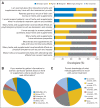National survey of US oncologists' knowledge, attitudes, and practice patterns regarding herb and supplement use by patients with cancer
- PMID: 25403205
- PMCID: PMC4517940
- DOI: 10.1200/JCO.2014.55.8676
National survey of US oncologists' knowledge, attitudes, and practice patterns regarding herb and supplement use by patients with cancer
Abstract
Purpose: Patients with cancer commonly use complementary and alternative medicine, including herbs and supplements (HS), during cancer treatment. This national survey explored oncologists' knowledge, attitudes, and practice patterns regarding HS use by their patients.
Methods: A survey was sent by mail and e-mail to a random sample of 1,000 members of the American Society for Clinical Oncology. The questions covered several topics: communication patterns, attitudes about HS, education about HS, response to HS use among hypothetical patients with cancer, knowledge of HS adverse effects, and demographic information.
Results: Among eligible oncologists, 392 (42%) responded to the questionnaire. Most were white (75%) men (71%), with a mean age of 48 years (standard deviation, 9.8 years). On average, oncologists discussed use of HS with 41% of their patients; only 26% of discussions were initiated by the oncologist. Two of three oncologists indicated they did not have enough knowledge to answer questions from patients regarding HS, and 59% had not received any education about the topic. Physician factors associated with having initiated discussions with patients about the use of HS included female sex, higher self-reported knowledge, prior education about HS, increased knowledge about HS adverse effects and interactions, and estimating that > 40% of one's patients with cancer use HS.
Conclusion: Fewer than one half of oncologists are initiating discussions with patients about HS use, and many indicate that lack of knowledge and education is a barrier to such discussions. Improving physician education about HS may facilitate more physician-patient communication about this important topic.
© 2014 by American Society of Clinical Oncology.
Conflict of interest statement
Authors' disclosures of potential conflicts of interest are found in the article online at
Figures

References
-
- Barnes PM, Bloom B, Nahin RL. Complementary and alternative medicine use among adults and children: United States, 2007. Natl Health Stat Report. 2008;12:1–23. - PubMed
-
- Dy GK, Bekele L, Hanson LJ, et al. Complementary and alternative medicine use by patients enrolled onto phase I clinical trials. J Clin Oncol. 2004;22:4810–4815. - PubMed
-
- Richardson MA, Sanders T, Palmer JL, et al. Complementary/alternative medicine use in a comprehensive cancer center and the implications for oncology. J Clin Oncol. 2000;18:2505–2514. - PubMed
-
- Bishop FL, Prescott P, Chan YK, et al. Prevalence of complementary medicine use in pediatric cancer: A systematic review. Pediatrics. 2010;125:768–776. - PubMed
-
- Richardson MA, Mâsse LC, Nanny K, et al. Discrepant views of oncologists and cancer patients on complementary/alternative medicine. Support Care Cancer. 2004;12:797–804. - PubMed
Publication types
MeSH terms
Grants and funding
LinkOut - more resources
Full Text Sources
Other Literature Sources
Medical

